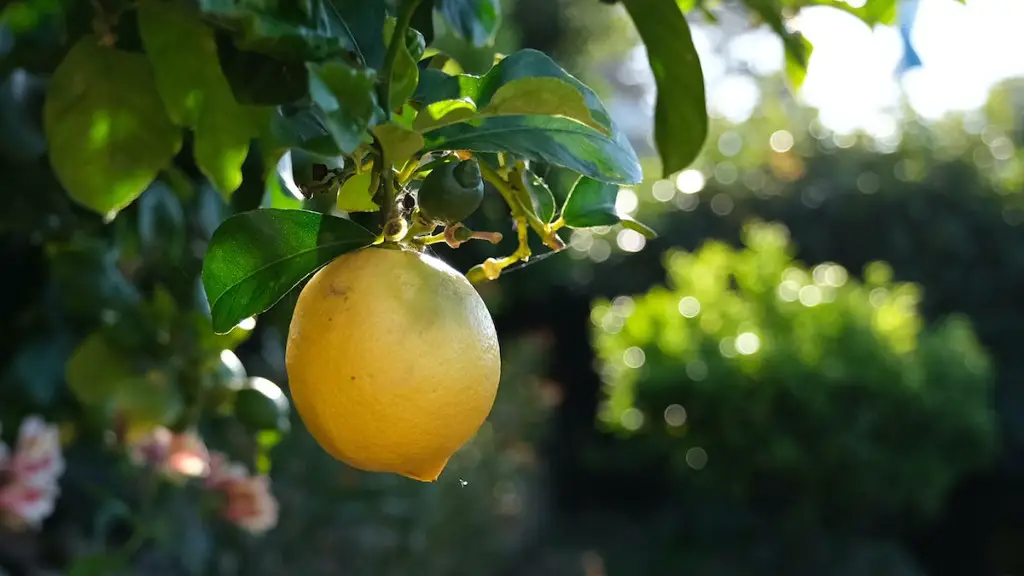Before attempting to transfer a lemon tree to a pot, there are several important steps that must be taken. Firstly, the planting area should be prepared with potting soil. The soil should have good drainage, so it is important to check that the area is well-drained prior to planting. Secondly, the lemon tree should be carefully pruned, so as not to damage any of the branches or flowers. This is particularly important if the tree has already produced lemons. Thirdly, a suitable pot should be selected. It should be large enough to allow for adequate drainage, as well as room for the tree to grow. Additionally, it should also have a drainage hole for excess water. Fourthly, the lemon tree should be placed in the pot, ensuring that the root system is spread out evenly. It is important to make sure that the roots have plenty of room to breathe and that the tree is firmly planted in the soil. Fifthly, the soil should be watered thoroughly and evenly. The water should be applied slowly, so as not to disturb the tree’s roots. It is important to ensure that the soil doesn’t become too wet, as this can cause the tree to become waterlogged. Lastly, the lemon tree should be fertilized throughout the growing season in order to keep it healthy.
Preparing the Soil
Preparing the soil is a key step when transferring a lemon tree to a pot. The soil should be well-drained, as too much water can suffocate the roots. Additionally, it should also have enough nutrients to support the tree. This can be accomplished by adding a quality compost, or a fertilizer specifically formulated for lemon trees. The compost should be added in small amounts and evenly distributed throughout the soil. Once the compost is in place, it should be mixed with the soil using a spade or shovel. Finally, the soil should be tested and adjusted as needed to ensure that it has the desired acidity and pH levels before planting the tree.
Pruning the Tree
Pruning a lemon tree prior to transferring it to a pot is essential. This is especially true if the lemon tree has already produced lemons, as it will prevent the tree from producing more. Pruning should involve carefully examining the tree and removing any dead or damaged branches, as well as any diseased fruit. Additionally, pruning should involve gently trimming the branches back to keep the tree in a healthy state. Pruning should only be done with the proper pruning shears, as any other tool could cause damage. Furthermore, the cuts should be sharp and clean, so as not to damage the tree’s bark.
Selecting a Pot
Selecting a pot for a lemon tree is very important. The pot should be large, as it will allow for adequate drainage. Additionally, it should have a drainage hole so that any excess water can escape. It is also important to consider the depth of the pot. A deeper pot will give the roots of the tree more room to spread out, allowing the tree to grow more vigorously. Furthermore, the material of the pot also matters. Clay pots are popular as they are porous, allowing for better drainage, but plastic pots can also be used.
Transplanting the Tree
Once the pot is selected, the actual transplanting of the lemon tree can begin. The tree should be carefully taken out of its existing container and placed into the new pot. It is essential to make sure that the roots are spread out evenly and do not get tangled. Additionally, the root system should not be broken or disturbed during this process. Once the root system is in place, the lemon tree should be firmly planted into the soil, ensuring that it is secure.
Watering the Lemon Tree
Once the lemon tree is firmly in place, it should be watered thoroughly. The water should be applied slowly and evenly, making sure to avoid any dry spots. Additionally, the soil should not be over-watered, as this can cause the tree to become waterlogged. The soil should also be tested for moisture levels before and after watering, as this will help determine how often the tree needs to be watered.
Fertilizing the Lemon Tree
Fertilizing the lemon tree throughout the growing season is important. A quality fertilizer should be used to ensure that the tree receives the essential nutrients it needs to thrive. Additionally, it is important to use the right amount of fertilizer, as too much can burn the roots and damage the tree. Fertilizers specifically designed for citrus trees should be used, as they contain the right balance of nutrients for the best results.
Managing Soil pH
The soil pH of the lemon tree’s pot should also be tested and managed. Lemon trees prefer a slightly acidic soil pH, so it is important to adjust the soil as needed. This can be accomplished by adding a small amount of sulfur to the soil. Additionally, the soil should be tested post-transplant, as this will allow for any necessary adjustments to be made quickly.
Keeping an Eye on the Tree
Once the lemon tree is transplanted, it is important to keep a close eye on it. The tree should be monitored for signs of stress, such as wilting leaves or discolored branches. Additionally, it is important to make sure that the tree is getting enough water and has enough room to spread its roots. Any problems that arise should be addressed as soon as possible to avoid further damage.


